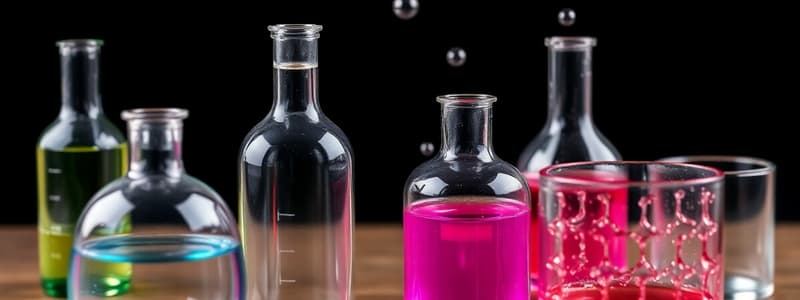Podcast
Questions and Answers
What determines the atomic number of an element?
What determines the atomic number of an element?
- The total mass of the atom
- The total number of electrons in the atom
- The number of neutrons in the nucleus
- The number of protons in the nucleus (correct)
Which of the following statements about acids and bases is true?
Which of the following statements about acids and bases is true?
- Acids release hydroxide ions in water.
- Acids release hydrogen ions in water. (correct)
- A pH of 9 is considered neutral.
- Bases increase the concentration of hydrogen ions in solutions.
Which application of stoichiometry is essential for balancing chemical equations?
Which application of stoichiometry is essential for balancing chemical equations?
- Determining the temperature of a reaction
- Measuring the pH of a solution
- Calculating the amounts of reactants and products (correct)
- Identifying the type of chemical reaction
Which statement accurately describes the properties of gases?
Which statement accurately describes the properties of gases?
Which of the following factors does NOT affect the rate of a chemical reaction?
Which of the following factors does NOT affect the rate of a chemical reaction?
Which branch of chemistry focuses on carbon-containing compounds?
Which branch of chemistry focuses on carbon-containing compounds?
What is an example of an intensive property of matter?
What is an example of an intensive property of matter?
Which type of chemical bond involves the sharing of electrons between atoms?
Which type of chemical bond involves the sharing of electrons between atoms?
What term describes the substances that undergo change in a chemical reaction?
What term describes the substances that undergo change in a chemical reaction?
Which state of matter is characterized by having a fixed shape and volume?
Which state of matter is characterized by having a fixed shape and volume?
What do molecules consist of?
What do molecules consist of?
Which of the following properties of matter is considered extensive?
Which of the following properties of matter is considered extensive?
What is the primary focus of analytical chemistry?
What is the primary focus of analytical chemistry?
Flashcards
What is Chemistry?
What is Chemistry?
The study of matter and its properties, composition, and changes.
What is Organic Chemistry?
What is Organic Chemistry?
It focuses on the study of carbon-containing compounds, crucial for life processes.
What is Inorganic Chemistry?
What is Inorganic Chemistry?
It deals with the study of elements and their compounds, excluding those traditionally considered organic.
What is Physical Chemistry?
What is Physical Chemistry?
Signup and view all the flashcards
What is Analytical Chemistry?
What is Analytical Chemistry?
Signup and view all the flashcards
What is Biochemistry?
What is Biochemistry?
Signup and view all the flashcards
What is matter?
What is matter?
Signup and view all the flashcards
What are Atoms?
What are Atoms?
Signup and view all the flashcards
What is the basic structure of an atom?
What is the basic structure of an atom?
Signup and view all the flashcards
What is an atom's atomic number?
What is an atom's atomic number?
Signup and view all the flashcards
What are acids?
What are acids?
Signup and view all the flashcards
What is the pH scale?
What is the pH scale?
Signup and view all the flashcards
What is chemical kinetics?
What is chemical kinetics?
Signup and view all the flashcards
Study Notes
Introduction to Chemistry
- Chemistry is the study of matter, its properties, composition, and the changes it undergoes.
- It encompasses a vast range of phenomena, from the smallest subatomic particles to the largest galaxies.
- It's a fundamental science underpinning disciplines like biology, physics, and engineering.
- It explores the structure, properties, and reactions of substances.
Branches of Chemistry
- Organic Chemistry: Focuses on carbon-containing compounds, crucial for life processes.
- Inorganic Chemistry: Studies elements and compounds, excluding traditional organic compounds.
- Physical Chemistry: Explores matter's physical properties, including thermodynamics, kinetics, and equilibrium.
- Analytical Chemistry: Develops methods to analyze substance composition and structure.
- Biochemistry: Investigates chemical processes within living organisms.
Matter and its Properties
- Matter is anything with mass and occupies space.
- Matter exists in three states: solid, liquid, and gas.
- Extensive properties depend on substance amount (e.g., mass, volume).
- Intensive properties are independent of substance amount (e.g., density, boiling point, melting point).
Atoms and Molecules
- Atoms are the basic building blocks of matter.
- Atoms consist of protons, neutrons, and electrons.
- Molecules form when two or more atoms bond chemically.
- Molecular arrangement determines properties.
- Molecules can be organic or inorganic.
Chemical Bonding
- Chemical bonds hold atoms together in molecules.
- Types include ionic, covalent, and metallic bonds.
- Ionic bonds involve electron transfer.
- Covalent bonds involve electron sharing.
- Metallic bonds involve valence electron sharing among many atoms.
Chemical Reactions
- Chemical reactions rearrange atoms to form new substances.
- Reactants are the substances changing.
- Products are the new substances formed.
- Chemical equations represent reactions, showing reactants and products.
States of Matter
- Solids have fixed shape and volume.
- Liquids have fixed volume, taking container shape.
- Gases have neither fixed shape nor volume; filling the container.
Atomic Structure
- Atoms have a nucleus with protons and neutrons.
- Electrons orbit in energy levels (shells).
- Atomic number is the number of protons.
- Elements are arranged on the periodic table by atomic number.
Periodic Table
- The periodic table organizes elements by atomic structure and properties.
- Elements in the same column (group) share similar properties.
- Elements in the same row (period) have increasing electron shells.
- Elements are classified as metals, nonmetals, or metalloids.
Acids and Bases
- Acids release hydrogen ions (H+) in water.
- Bases release hydroxide ions (OH-) in water.
- The pH scale measures acidity/basicity.
- pH 7 is neutral, below 7 is acidic, above 7 is basic.
- Acids and bases react in neutralization reactions.
Stoichiometry
- Stoichiometry studies quantitative relationships in chemical reactions.
- It involves calculating substance amounts in reactions.
- Balancing chemical equations is vital in stoichiometry.
Thermodynamics
- Thermodynamics studies heat and energy relationships.
- Key concepts include enthalpy, entropy, and Gibbs free energy.
- These concepts predict reaction spontaneity.
Kinetics
- Kinetics studies reaction rates.
- Factors affecting reaction rates include temperature, concentration, and catalysts.
- Understanding reaction rates is essential in industry.
Studying That Suits You
Use AI to generate personalized quizzes and flashcards to suit your learning preferences.




